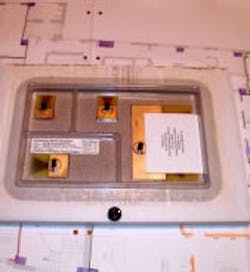Until a problem rears its head, ceilings typically don’t catch your attention. A dusty, dirty, or stained ceiling, however, can negatively impact perceptions of the space.
Depending on the ceiling’s condition, you may be able to get by with a quick sweep, while other occasions require replacement. Assess the type, size and severity of your ceiling’s problem to determine your next step.
1. Basic Maintenance
The ceiling’s cleaning schedule depends on its location. Tiles used in kitchens, such as hard vinyl sheetrock, should be cleaned every 8-10 months, says Roy Paget, president of Acousta-Kleen of Central Florida. Applications using the classic white mineral board generally aren’t exposed to heat, smoke, and kitchen grime, so they can make do with an 18-month gap between cleanings.
[On topic: Top 5 Envelope Failures and Water Leaking Solutions]
To remove any dust, cover your furnishings and brush or vacuum the ceiling according to the manufacturer’s directions. A professional cleaner may include this in a service package and spray the ceiling with an enzyme detergent containing hydrogen peroxide.
“There are many reasons why facilities managers should not spray the ceiling themselves, mainly because a ceiling cleaning solution is an industry-specific product that you can’t go down to the store and buy,” Paget explains. “I’ve seen people try to get up there with degreasers and other cleaning agents and destroy the ceiling.”
The cleaning professional should have several years of experience and be able to explain the process in detail, Paget adds.
“Have them explain how they go about it and what they use,” Paget says. “If they say anything other than an enzyme detergent with a small percentage of hydrogen peroxide activator, they should not be doing your ceiling. If they tell you they mix the enzyme detergent and then put in as much hydrogen peroxide as they think is needed, that’s a red flag.”
2. Small Stains
If small stains seem uncleanable and you’ve resolved the issue that stained them, it’s safe to cover up the spot as long as you use a product that protects the tiles’ acoustic and fire ratings, such as Kilz Upshot, Paget explains. Don’t slap any old paint on the tiles – this risks the ceiling’s fire rating and could destroy its acoustical properties.
[Related: Mold and Liability]
“Keep in mind that all of those little fissures in the ceiling have a purpose – to absorb sound,” explains Cindy O’Neill, assistant marketing communications specialist for ceiling and wall systems manufacturer Armstrong. “You’re going to fill up some of those holes, which can make a big difference in the performance.”
Be sure to review the ceiling manufacturer’s directions carefully so you don’t void the warranty, O’Neill adds.
“If you’re scrubbing something that’s not meant to be scrubbed, that could damage the acoustical properties as well,” O’Neill says. “The manufacturer won’t be able to stand behind the performance of their product if it’s been altered with excessive cleaning or painting.”
3. When Replacement Is Best
It’s extremely difficult to restore water-damaged mineral board, Paget says. In addition to an ugly stain, the affected ceiling tiles may harbor mold or mildew. For this and certain other cases, it may be more cost-effective to replace the damaged part of the ceiling, especially if it’s suffering from major staining that would require more than just a blast of detergent.
“If it looks really bad, consider replacing it. Visually, it will make a big difference. A stained ceiling is really unappealing,” O’Neill says.
Consider your building type and climate when you opt for replacement. If your ceiling is frequently exposed to humidity or moisture, used in a sterile environment, or requires frequent cleaning, consider washable materials that won’t buckle when wet. Such tiles may not have high acoustic ratings, so determine your priorities before purchasing.
“If you have to replace 10% of the panels every year, that’s considerable labor cost,” explains Dave Blurton, marketing director for Acoustic Ceiling Products, which manufactures PVC-based ceiling tiles. “The labor cost to clean and maintain a PVC ceiling tile is considerably less than replacing mineral board.”
Sometimes replacement is unavoidable, but you can minimize the need by sticking to your regular cleaning schedule. Fold this task into your team’s other cleaning plans to keep costs down, O’Neill advises. “Stay on top of your maintenance plan. Then you won’t have to worry as much about treating something that’s excessively dusty, dirty, or stained.”
Two handpicked articles to read next:
About the Author
Janelle Penny
Editor-in-Chief at BUILDINGS
Janelle Penny has been with BUILDINGS since 2010. She is a two-time FOLIO: Eddie award winner who aims to deliver practical, actionable content for building owners and facilities professionals.

